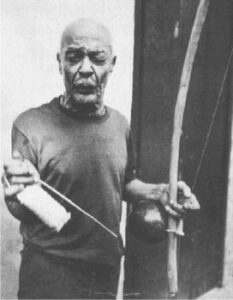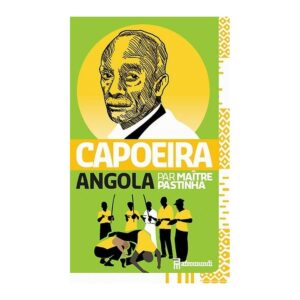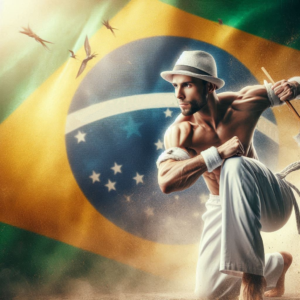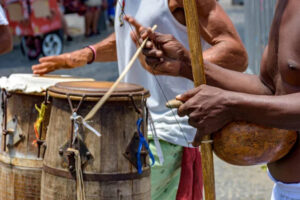Mestre Pastinha
Founder of the first Capoeira Angola academy
(5 aprile 1889 – 13 november 1981)
Whoever sees the fight, understands it better. It resembles a dance, but it’s not. Capoeira is a fight, and a violent one. It can kill, it has already done so
Introduction
Vicente Ferreira Pastinha, known as Mestre Pastinha, was born on April 5, 1889, in the city of Salvador, Bahia. Growing up in a poor family, his father, Jose Senor Pastinha, was a Spanish merchant who owned a small store in the historic center of Salvador. His mother, Dona Maria Eugenia Ferreira, was a Black Bahian woman. Mestre Pastinha began learning capoeira at the age of eight from the African master Benedito, who taught him this form of self-defense to protect himself from bullies.
Early Experiences and Naval Career
At twelve years old, under his father’s encouragement, Vicente enlisted in the Navy, where he continued to practice and teach capoeira to his fellow sailors until 1910. During his military service, Pastinha not only honed his martial skills but also developed a deep sense of discipline and respect, values that he would later pass on to his students. Over the years spent in the Navy, Vicente acquired considerable experience in martial life and hand-to-hand combat techniques, which enriched his knowledge of capoeira.
After leaving the military, he began teaching capoeira to Raymundo Aberrê, a promising young man who became one of his first students, and worked for the newspaper “Diário da Bahia.” During this period, Pastinha faced numerous economic difficulties, but his passion for capoeira never wavered. To support himself, he worked various jobs, including shoe shiner, painter, folk poet, and journalist. His versatility and creativity allowed him to make a living while continuing to dedicate himself to teaching capoeira.
Despite adversity, Pastinha managed to create a strong bond with the local community, earning the respect and admiration of many. His dedication to capoeira led him to found his own school, the “Centro Esportivo de Capoeira Angola,” where he could teach and promote capoeira as a martial art and form of cultural expression. Under his guidance, Angola capoeira flourished and spread, attracting a growing number of practitioners and enthusiasts.
Foundation of CECA
In 1941, Mestre Pastinha was invited by his student Aberrê to participate in the traditional Sunday roda in the neighborhood of Gengiborra. During this occasion, he met Mestre Amorzinho, a member of the Civil Guard and capoeirista, who encouraged him to open a capoeira teaching center. Thus, the CECA (Centro Esportivo de Capoeira Angola) was born, located at largo Pelourinho 19. This center trained many great capoeira masters such as Mestre João Grande, Mestre João Pequeno, Mestre Curiò, Mestre Gildo Alfinete, and other illustrious names in capoeira.
Intellectual Valorization of Capoeira
Thanks to Mestre Pastinha, the intellectual world began to take an interest in capoeira, valuing it through writers, painters, philosophers, and anthropologists such as Jorge Amado, Caribè, Jean-Paul Sartre, Pierre Verger, and the actor Jean-Paul Belmondo. Pastinha had a significant impact in making capoeira recognized not only as a martial art but also as a form of cultural and historical expression. His dedication and passion attracted the attention of important figures in the cultural and academic world, who saw in capoeira a symbol of the resilience and creativity of the Afro-Brazilian people.
In 1964, Pastinha published the book “Capoeira Angola,” a fundamental work that helped to spread knowledge and appreciation of Angola capoeira. The book offered a valuable testimony of the traditions and techniques of this martial art, becoming a source of inspiration for many scholars and practitioners. In the same period, Pastinha recorded an album with traditional rhythms and songs of Capoeira Angola, preserving and further spreading the musical culture associated with capoeira.
In 1966, Mestre Pastinha represented Brazil at the 1st World Festival of Negro Arts in Senegal, a major international event that celebrated the art and culture of African peoples and the diaspora. Pastinha’s participation in the festival was met with great enthusiasm and recognition, receiving various accolades from participants and promoters of the festival. This event not only consolidated his reputation as a capoeira master but also helped to strengthen cultural ties between Brazil and Africa.
Thanks to the efforts of Mestre Pastinha and his commitment to promoting capoeira, this martial and cultural discipline gained unprecedented attention, becoming the subject of study and admiration around the world. Capoeira was no longer seen only as a self-defense practice but as an important expression of the Afro-Brazilian cultural heritage, rich in history, tradition, and meaning.
Years of Difficulty and Final Days
Mestre Pastinha was the guardian of Capoeira Angola (traditional Capoeira). Despite a lifetime dedicated to teaching this Afro-Brazilian art, Mestre Pastinha did not receive the recognition he deserved. In 1971, already ill and nearly blind, he was forced to abandon his academy due to renovations in the Pelourinho, with the promise of being able to return once the work was completed. In the meantime, he was housed in a damp and windowless room located at Rua Alfredo Brito no. 4 – Pelourinho. However, the promise was not kept, and a restaurant was built in place of his gym. From that moment on, the entire structure belonged to the Senac (Serviço Nacional de Aprendizagem Comercial). Depressed and in deteriorating health, he suffered a cerebral edema in 1979 and, after a year of hospitalization in a public hospital, he was transferred to the Dom Pedro II clinic. On November 13, 1981, Mestre Pastinha, one of the most important figures in the history of capoeira, died blind and alone at the age of ninety-two, leaving an indelible legacy.












